While everyone loves a big double-aisle jet, and we’ve seen quite a few of those in the current era of aviation, regional jets still continue to play an important part in aviation, going to places where the big jets can’t go. Most of the Indian carriers have been using turbo-props to this effect, such as IndiGo’s ATRs, Air India’s ATRs (via Alliance Air) and SpiceJet’s Q400s. But these turboprops are not liked as much by the slot-constrained airports for sure, given they are slower, and don’t effectively use the capacity of the airport.
Over the years, with advances in technology, however, smaller jets have shed their tag of being regional operations to be able to fly much further as well. This capability allows airlines to start operating these aircraft not just for operations near but far.
The CSeries was a clean-sheet design for Bombardier, who designed the original aircraft, including the 100-135 seat CS100 and the 130-160 seat CS300 aircraft. In the case of the CSeries, the aircraft was designed integrating the P&W PurePower geared turbofans, which makes them the default and only options on this aircraft type. As we would find out on my flight, another option of engines would be hard to come by because of the engine and aircraft being so tightly integrated.
The aircraft programme, which was taken over by Airbus, and rebranded as the A220 in July 2018, complemented the existing lineup of Airbus very well, giving them a fly-by-wire aircraft with options in the 100-seater market where their own A320 aircraft would usually have 180 seats.
While I had been to the unveiling of the new aircraft in Toulouse in July 2018, and I’ve seen the aircraft many a time at various airshows. I’d still not gotten an opportunity to experience it.

The Airbus 220-300 on arrival in Toulouse in July 2018
In November 2019, Airbus decided to bring the aircraft on a demonstration tour to potential clients around the Asia-Pacific region, and India was on the tour. I was invited, along with some other journalists, to be a part of the flight between Bangalore and Delhi, to experience the power and the passenger experience of this aircraft.
A small jet such as the A220 allows airlines to launch routes without compromising on their ticket yields. As the traffic grows, one could up gauge to a larger aircraft. So, one does not need to start operating with a fleet of 180 seaters from Boeing / Airbus when opening a new station. This factor clubbed with the support capabilities of Airbus in India, has gotten a few start-up airlines considering this aircraft for their fleet.
In the current aviation market, which seems to prefer the frequency of flights, operating a smaller jet but more flights is sort of what the traveller wants. Regional jets are the lifeline of sorts of all American carriers. In India as well, they could do the job very well for a route that would need to be opened up and take time to mature. But not just that, the aircraft has an excellent range as compared to the turboprops which Indian airlines prefer for regional operations. Not only would these jets fly, let’s say between Mumbai and Jodhpur, but they can also operate flights from Delhi to Singapore non-stop as well with a 100 passengers on board. In fact, Air Baltic, on whose aircraft I flew for the demonstration, already flies this aircraft between Riga (Latvia) and Abu Dhabi (UAE) on a daily basis, doing about 2700 miles.
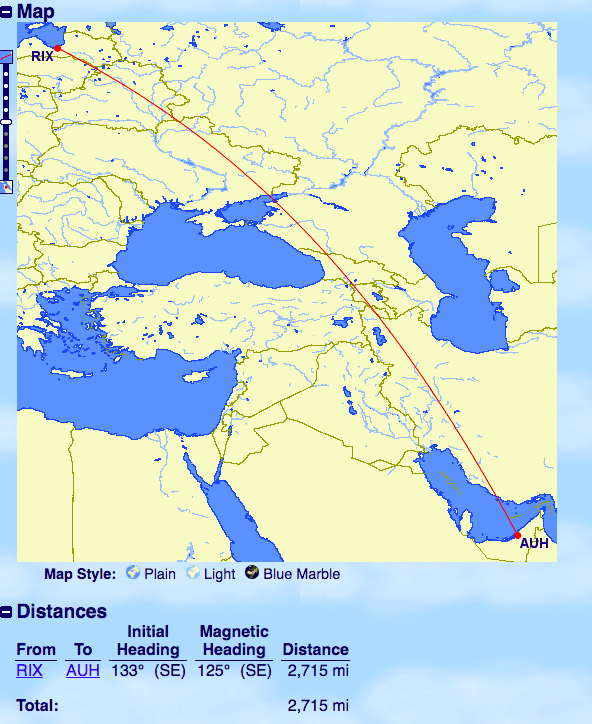
The flight between Bangalore and Delhi was scheduled to depart at 3:30 pm, but as it turned out, the demonstration flight happened about the same time, leaving us to depart on the golden hour. After going through the security check and getting driven to the plane on a bus, here was the first view of the aircraft. Airbus has had Air Baltic, one of their customers, showcase the aircraft with them for years. The aircraft has worked very well for the airline, allowing them to discontinue their ageing Boeing 737 fleet and become an all A220 operator.
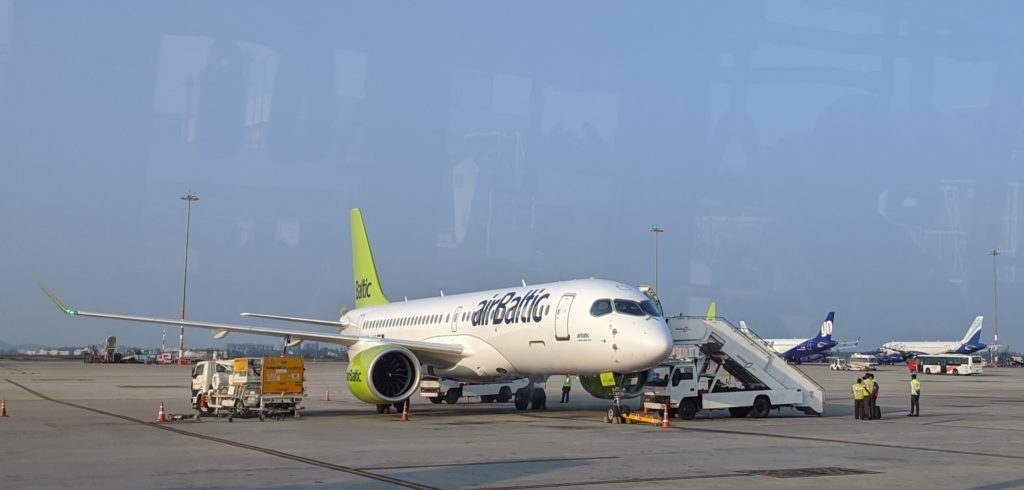
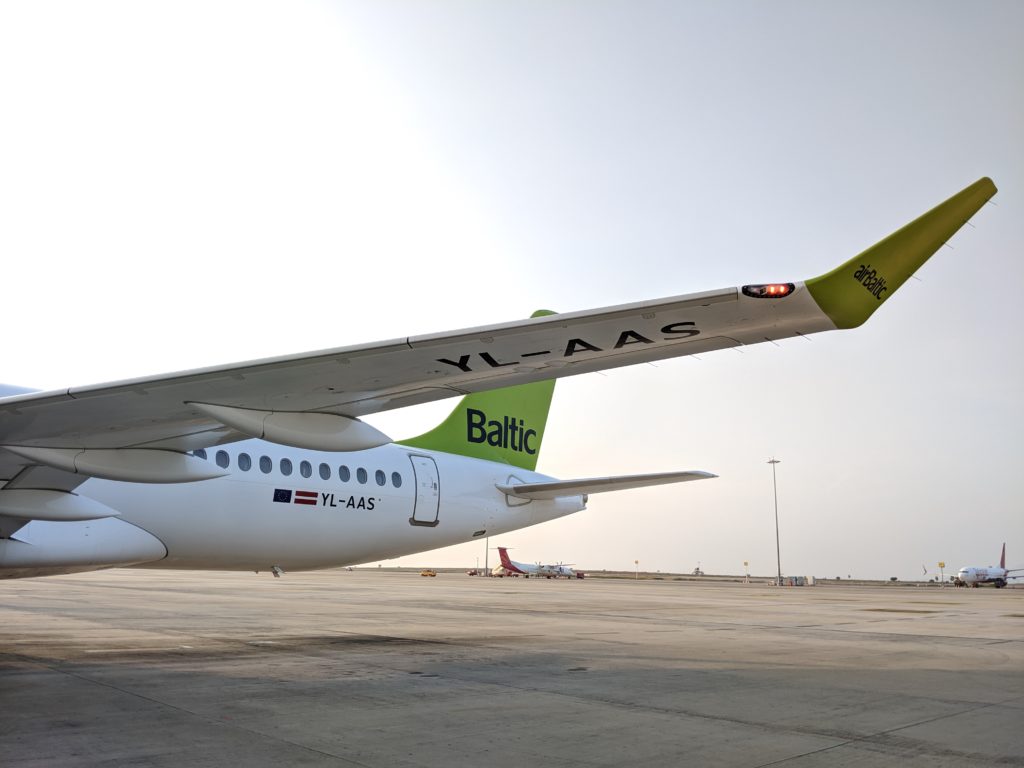
On this flight, I was travelling with my backpack and my cabin-bag, to be able to test the aircraft’s passenger experience.
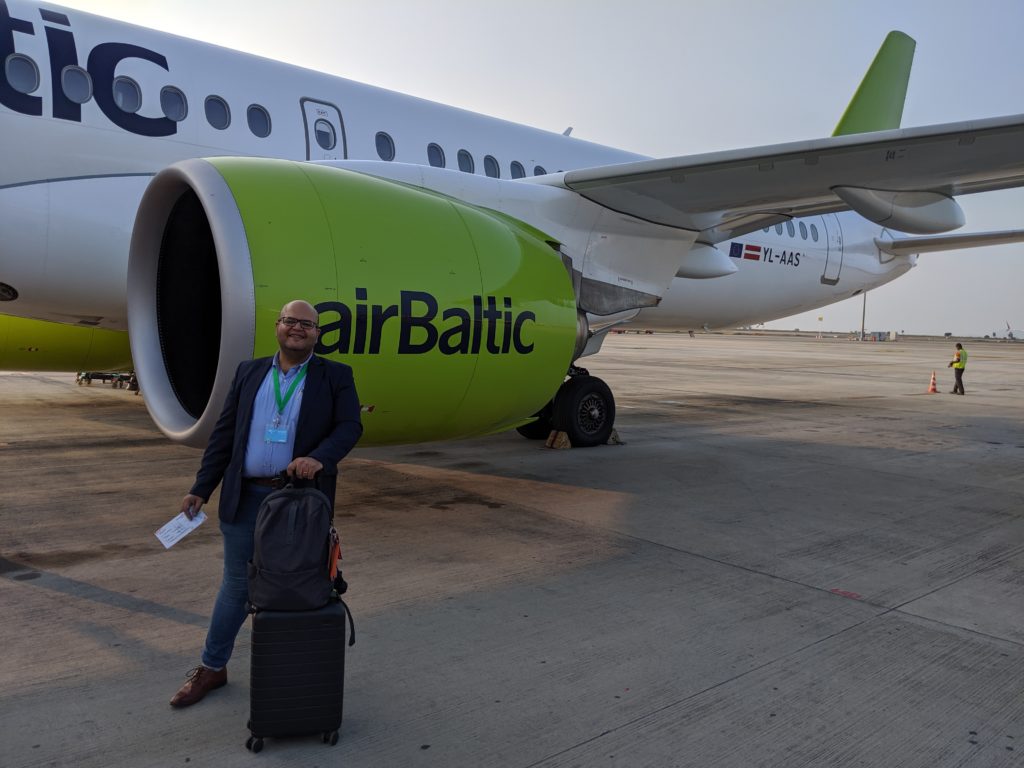
On the inside, the A220 is designed with 2-3 seat layout, which means there is still a middle-seat to take care of. But given the aircraft is not the derivative of any other aircraft, it allowed for the installation of wider seats. So while the A220 seats are at least 18.5″ wide on shoulder length (compared to 18″ on the A320 and 17″ on the 737), this gives the opportunity to travel on the widest middle-seat in the sky, if you ever get into one.
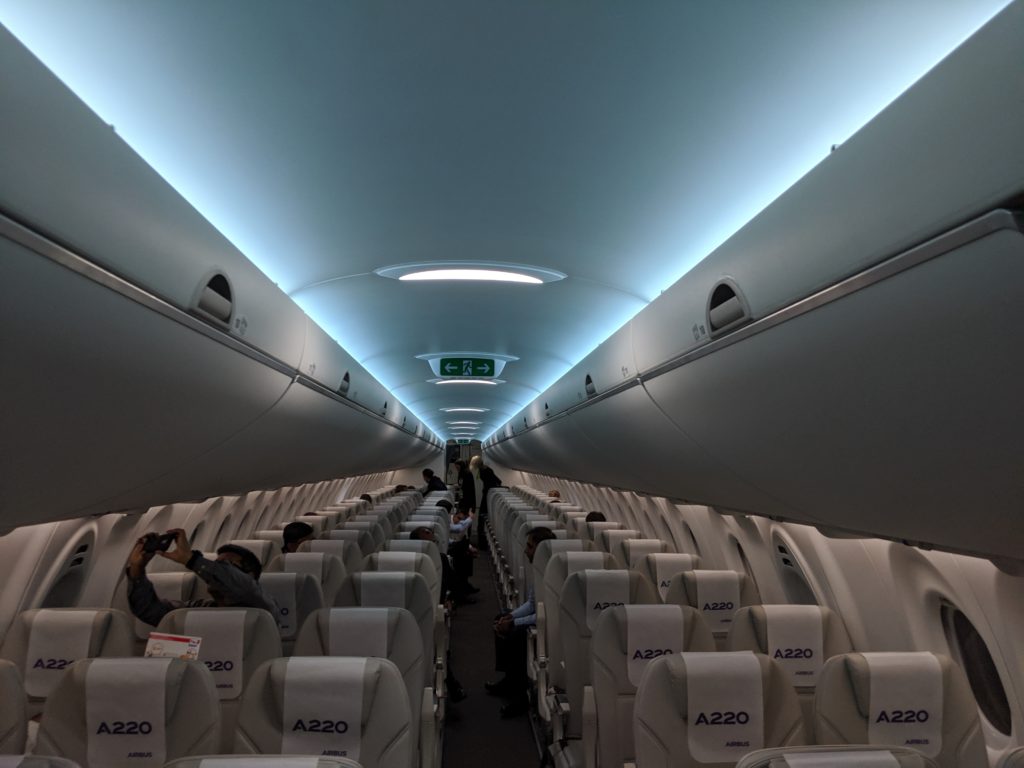
At the front of the cabin, there is a small business class cabin, configured by Air Baltic in the European J Class fashion, with an empty middle seat. But another operator could just use a different seat altogether. For instance, Delta, which is building up a fleet in the USA with these aircraft, has a 2-2 fleet of Business Class seats (First Class in US), and then 3-2 in the back.
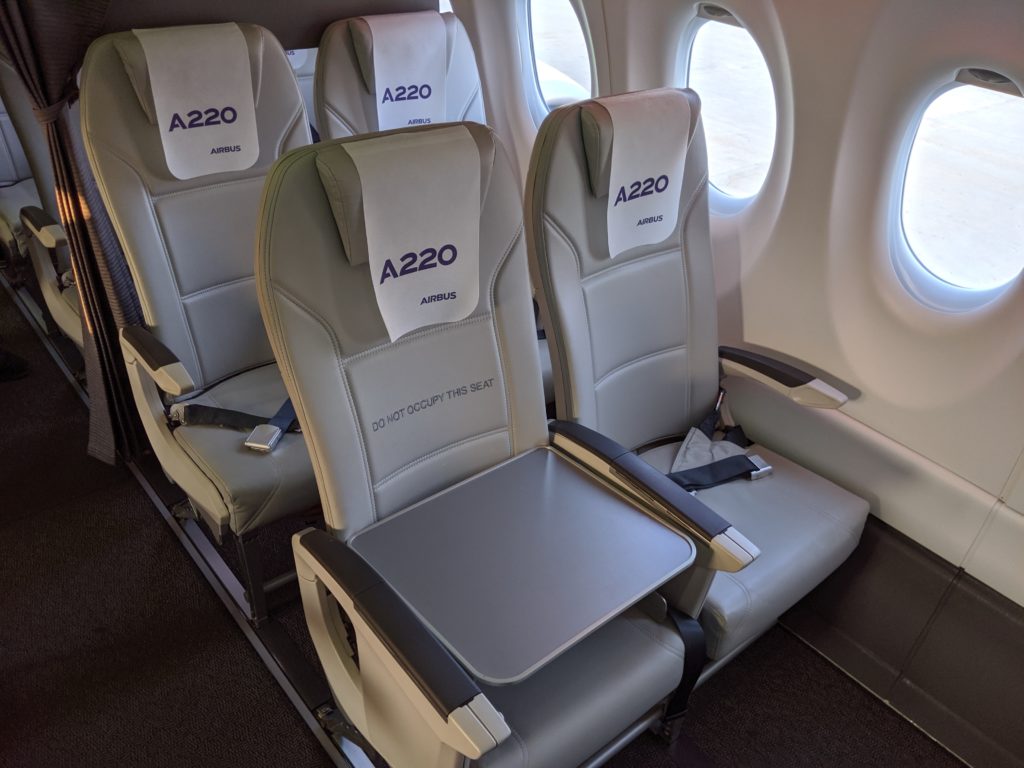
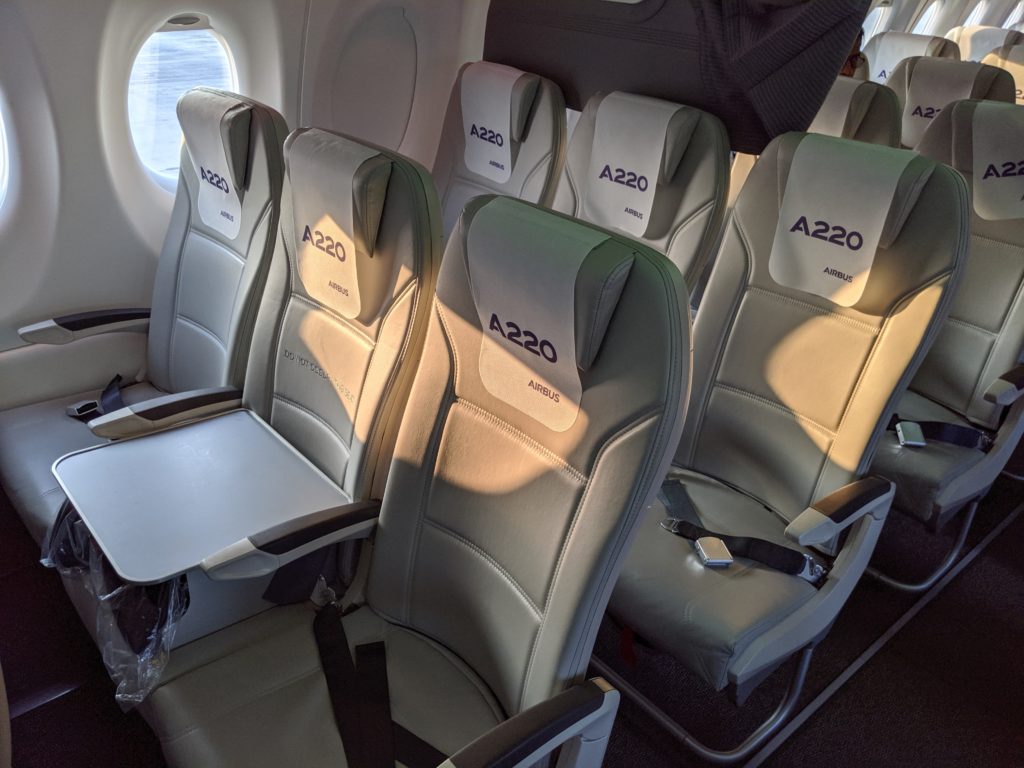
The economy section then becomes very very spacious as well for the passengers. At a 30″ seat pitch, there was ample space, and then some more in the sole emergency exit row of this aircraft. (Being a smaller passenger capacity jet means that the aircraft needs a lesser number of emergency exit doors for passengers)
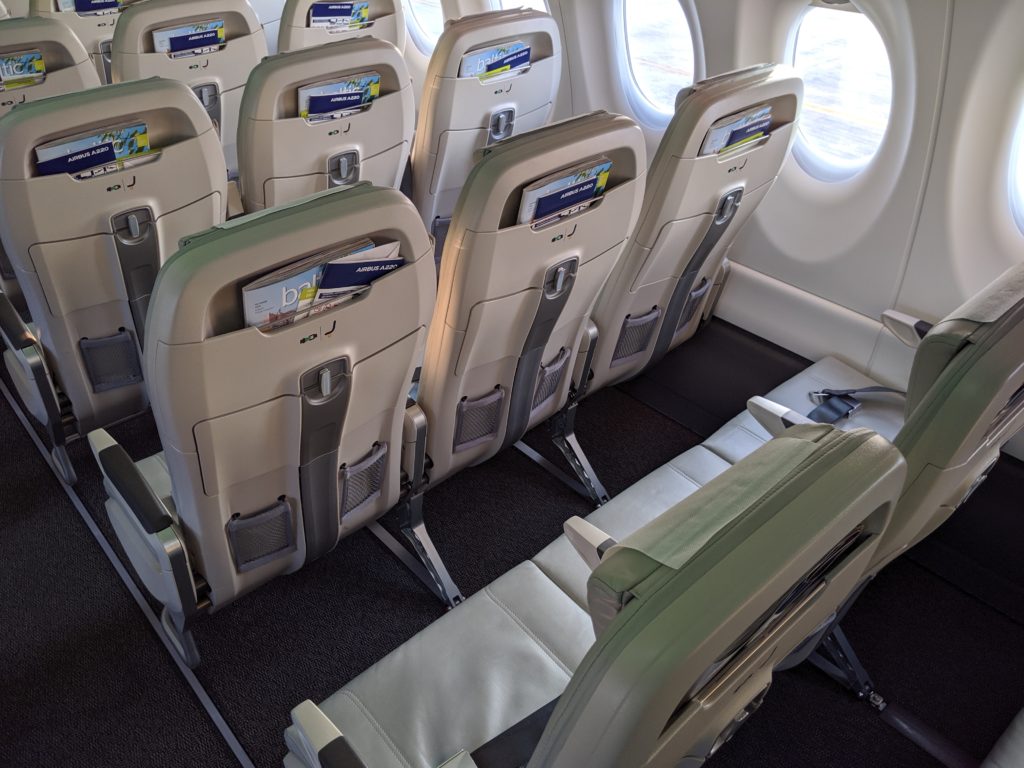
Passenger experience has been duly taken care of on this aircraft. the seats have the magazine and literature holders on the top, giving more space around the knees. As you would see, there are a couple of small pockets at the bottom, one to hold a water bottle and another to hold your personal effects like a passport or glasses and stuff.
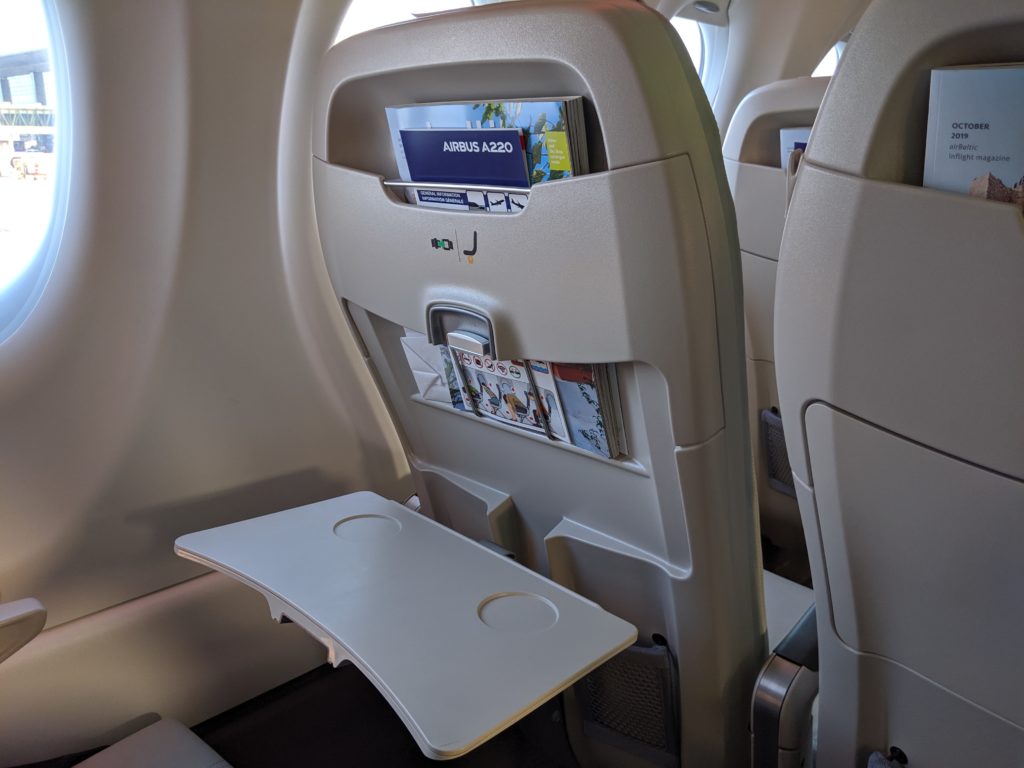
Each seat also came with a coat hook, making it easier to carry jackets without having to stow them in the overhead bin.
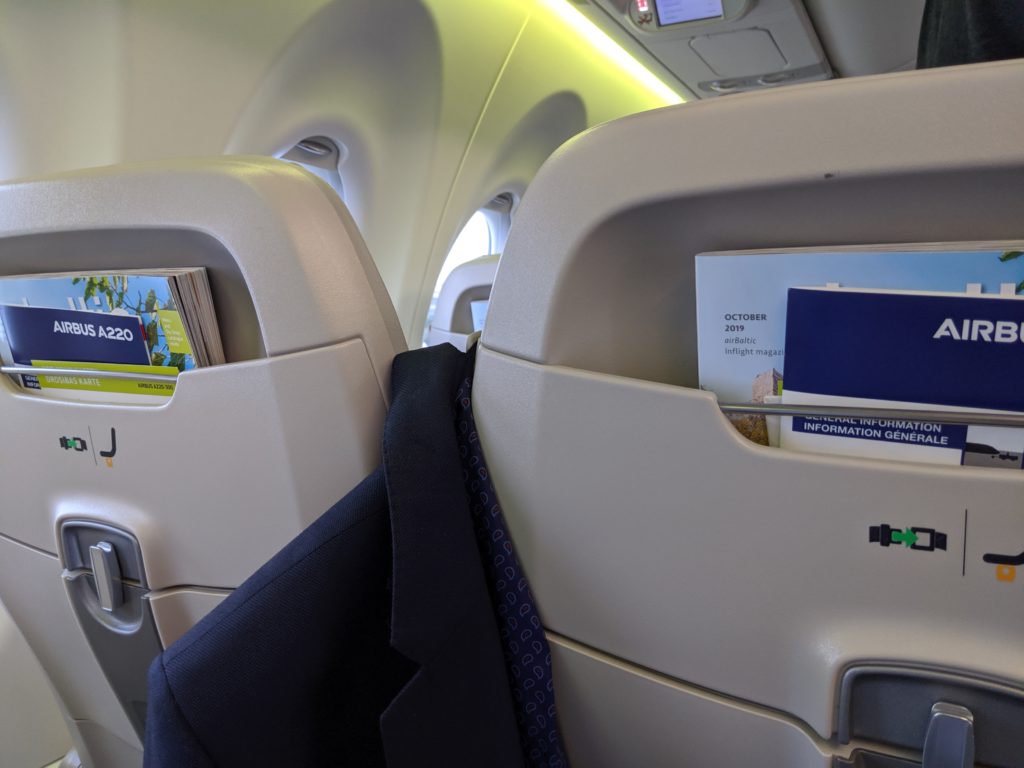
The aircraft has some nice and roomy windows and the aircraft design allows for a lot of light to stream in as well. This makes the aircraft look very spacious.
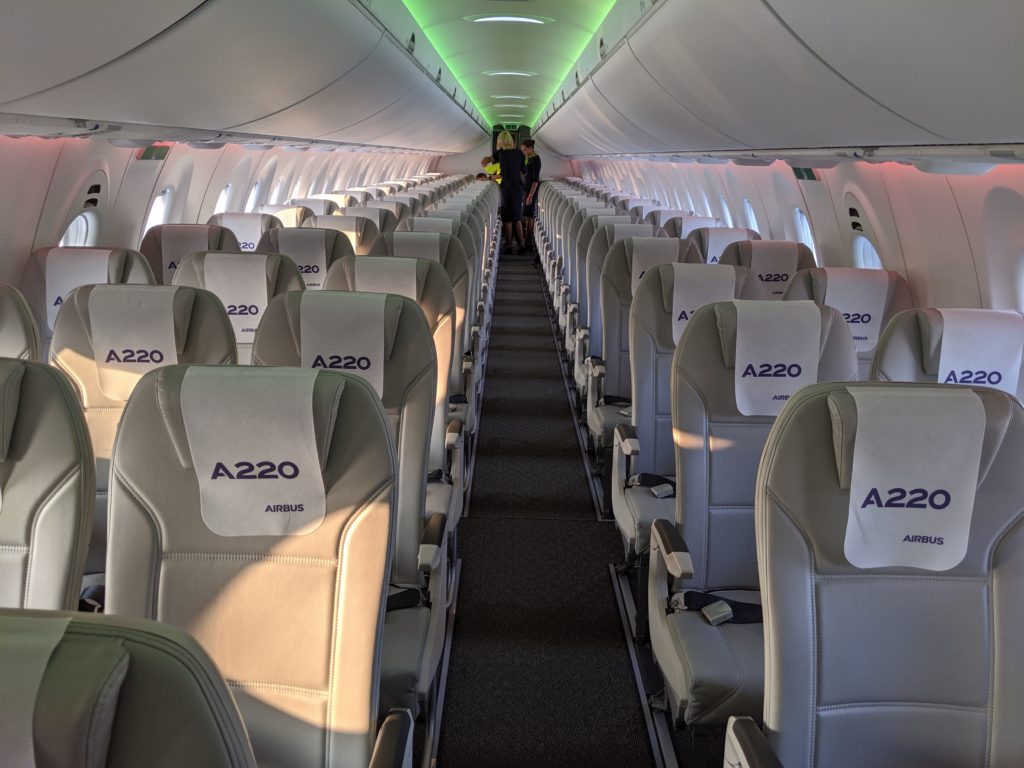
The aircraft has some very spacious cabin baggage bins, stowing 4-5 big cabin bags at a time. However, the bins are not as high as some of the other narrowbody aircraft in service, and that means a customer can’t stand, especially on the window seats. For me, for instance, on an A320, I could stand with my head angled before getting out of my window seat, but here, no such luck.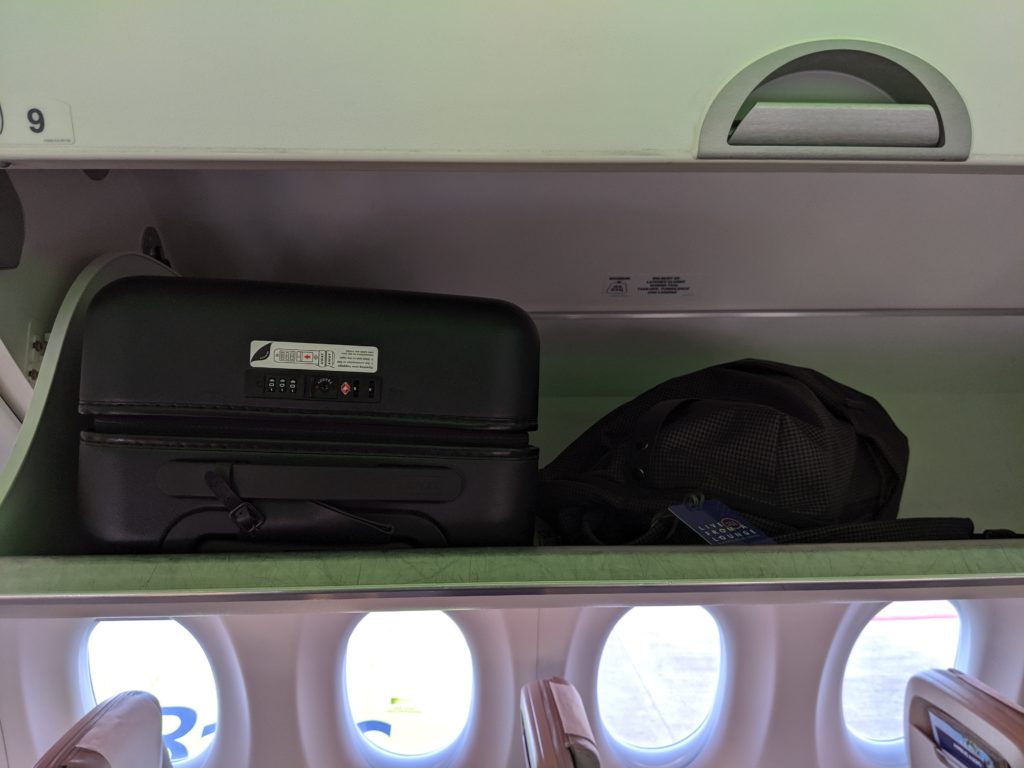
A quick trip to the cockpit showcased the all-digital cockpit of this aircraft. The A220 has the fly-by-wire philosophy, meaning one could fly the aircraft with a sidestick (hidden behind the pilots in the image), just like you would do for a flight simulator game. Also, the four screens have focussed on replacing as many knobs as they could, making all the data and choices available digitally instead.
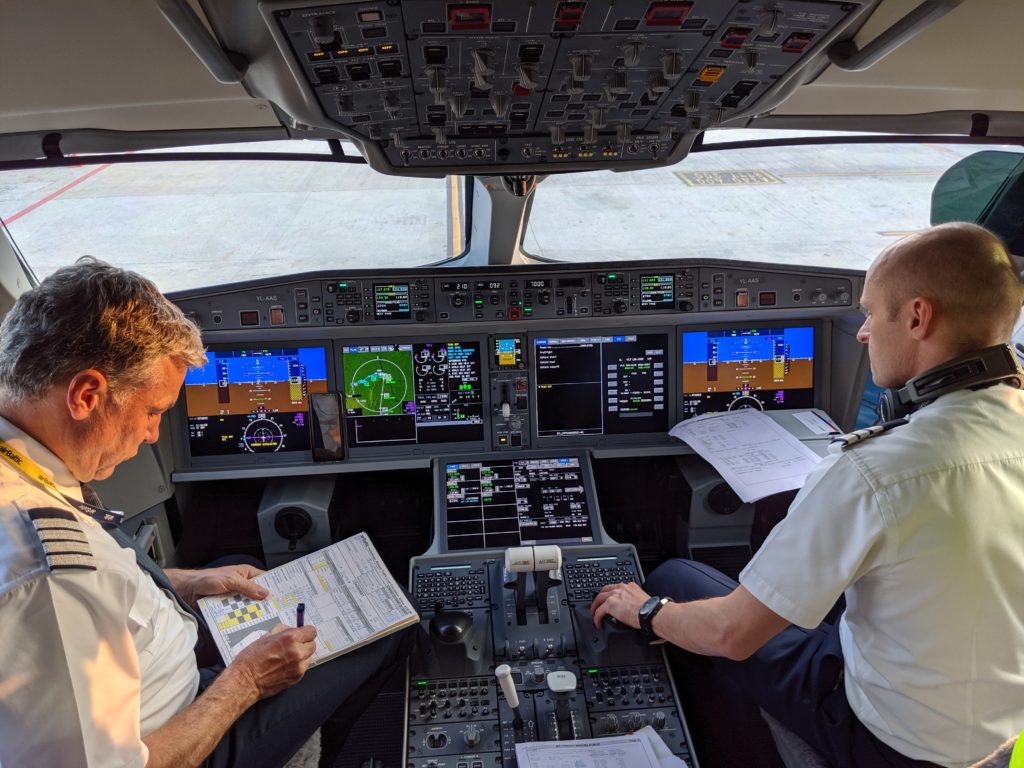
Of course, the legacy of Bombardier still shone on these aircraft, since many parts still carry the Bombardier branding.

We finally got strapped in for our flight and got moving. The flight was being operated by YL-AAS, an aircraft delivered to Airbus just in May 2019, and the aircraft had flown across the Asia Pacific for this tour. Bangalore and Delhi were the last stops, and the plane was going to return to Latvia after this trip.
One beautiful thing about the aircraft is that each seat has an overhead monitor. I could watch the moving map on this little monitor, and all the safety demonstrations were also displayed here. Would this serve as an IFE monitor? No. For that, one would have to install streaming solutions or different seats, as Delta did with seatback entertainment in their new A220s.
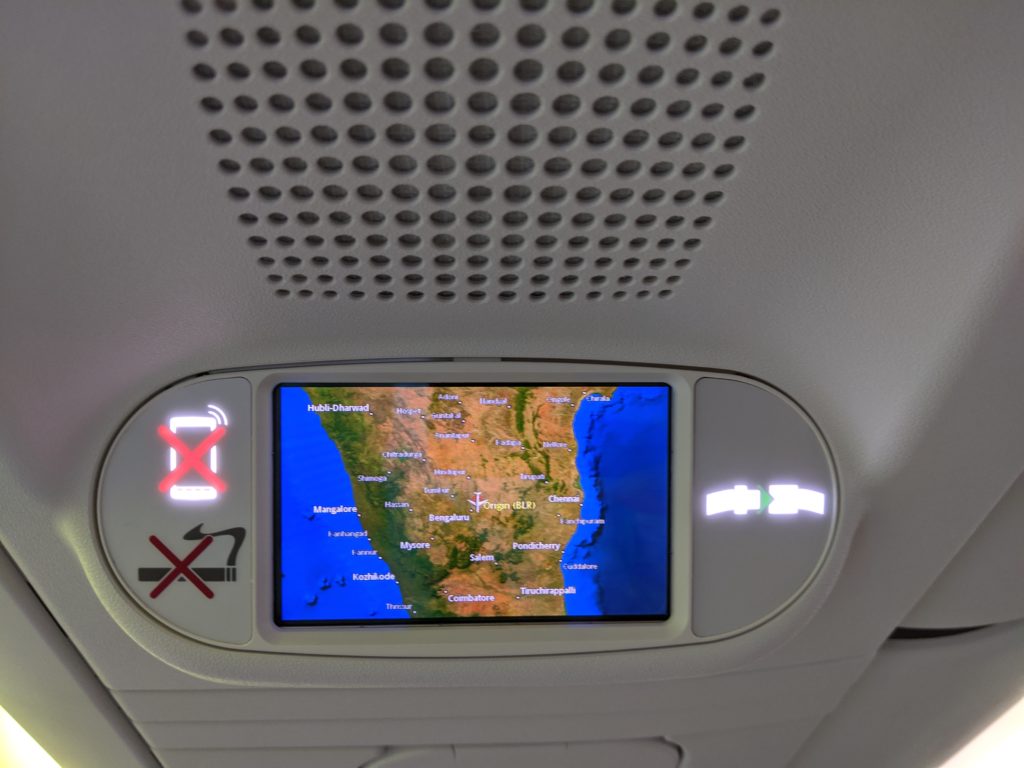
Our departure out of Bangalore was smooth, and departing at the golden hour gave us some exceptionally beautiful views outside of the windows.
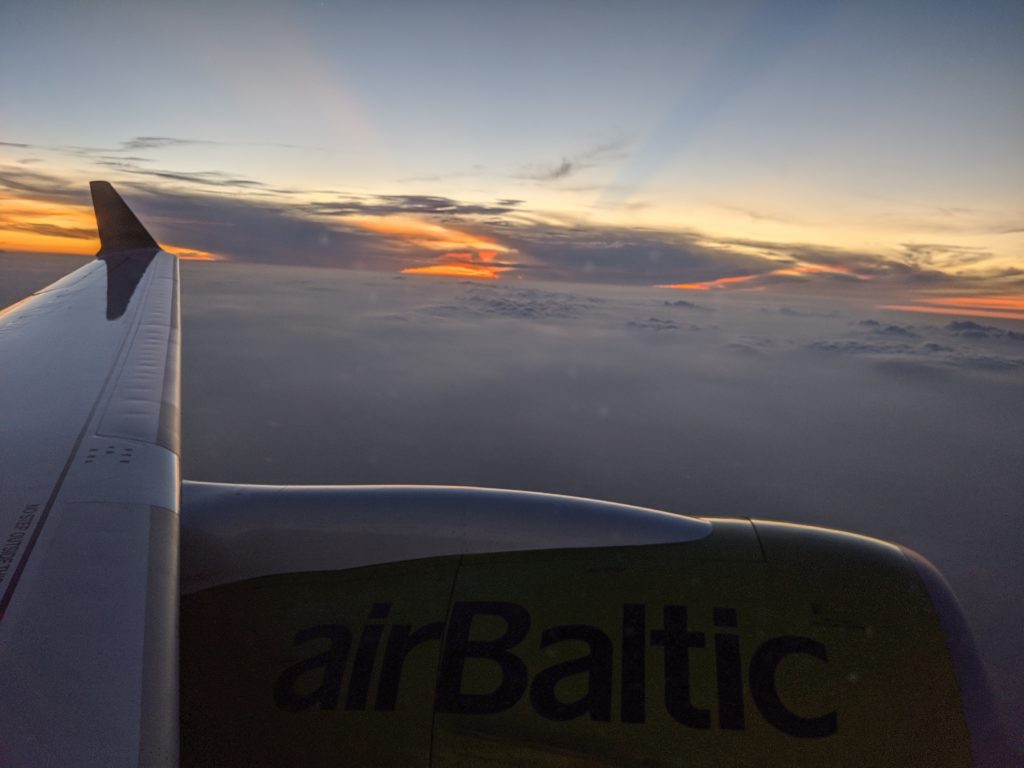
The big windows had some beautiful sights outside.

We flew past Hyderabad on our way to Delhi, and Google Pixel’s Night Sight was able to give me a lovely image.
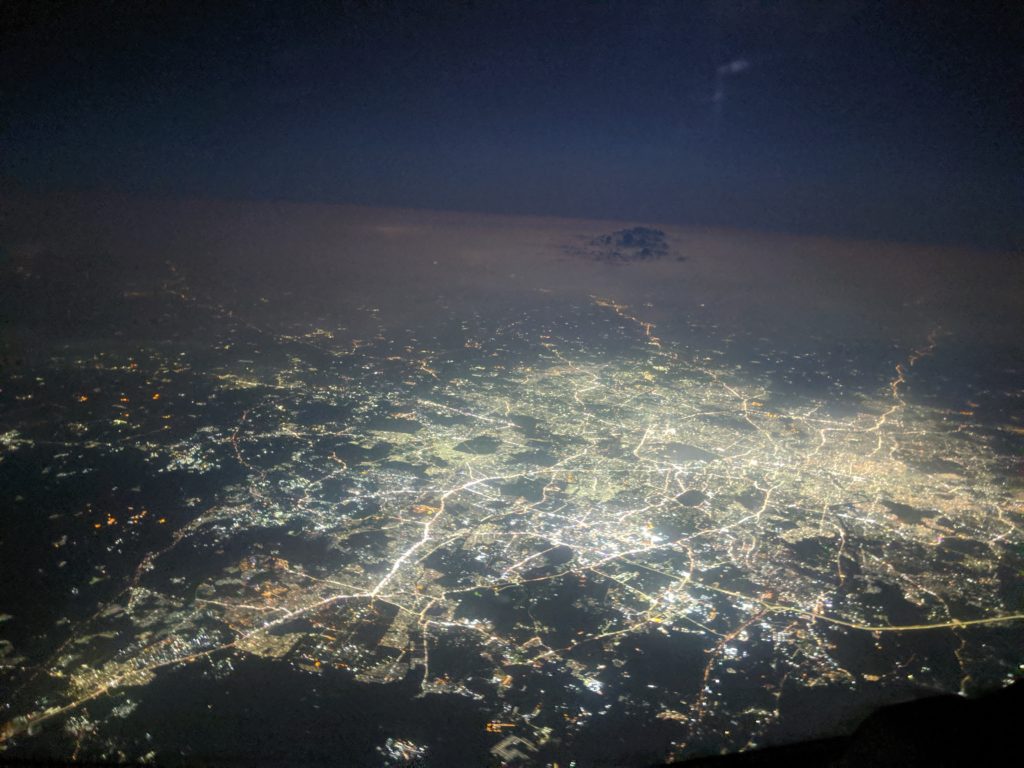
Another thing to notice was that this was a very quiet take off. The decibel meter showed it to be as loud as the A320 with CFM engines at about 70 decibels.
Soon enough, it was time to meet Connor Buott, the Airbus Single Aisle Product Marketing Senior Analyst, Customer Affairs, who was interacting with media. He said the aircraft had been having exceptional dispatch reliability across the globe with all the customers, and that in India, there were a couple of business cases for the aircraft. One, for the regional market, such as the UDAN scheme, where one could use a smaller jet due to the limited number of seats that would be filled. Similarly, for the major airlines, they could use this aircraft to start routes which could be later up gauged as the market grew.
Airbus/Air Baltic had also organised meals for this flight. It was a great time to check out many small nuances of this aircraft. For instance, how many times have you had to wait for your meal cart to pass to be able to head to the washroom. On this aircraft, even people like me, who are on the broader side, could just squeeze through. There was more than enough space to do that.
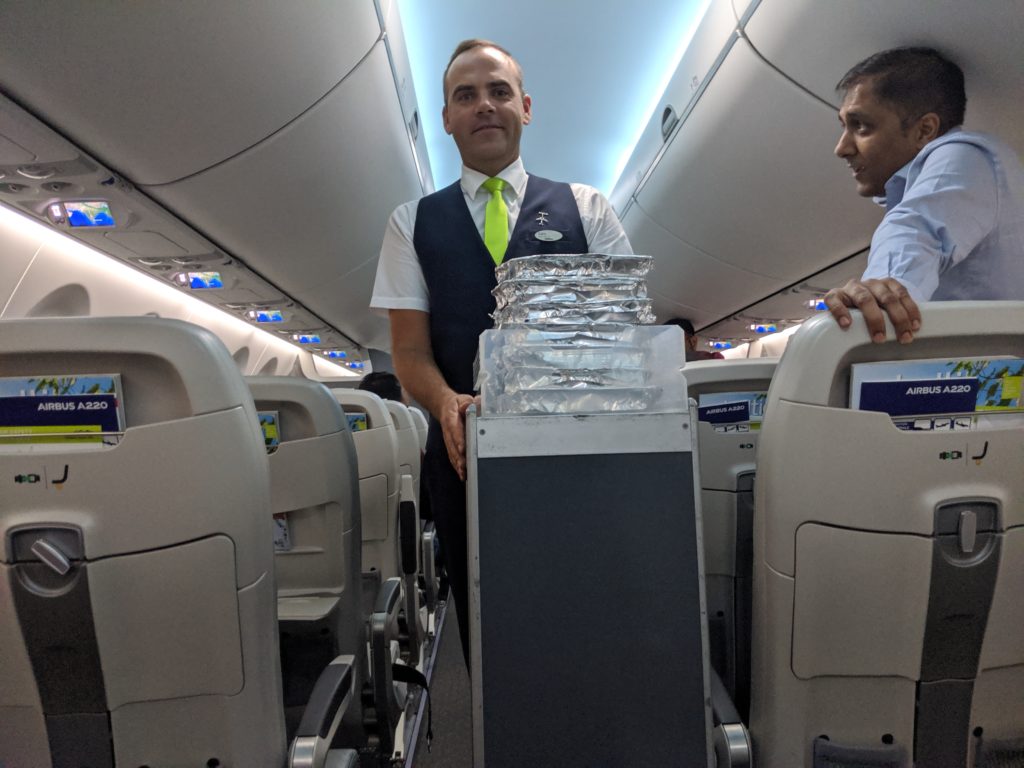
And not just that, there was enough space for me to work on my laptop.

And for those of us who hate the new small lavs on the jets, trying to maximise the use of space, the A220 had some really big lavs, although there were only two of them on this aircraft.

The mood lighting on the aircraft worked beautifully, and we were treated to an early Christmas.
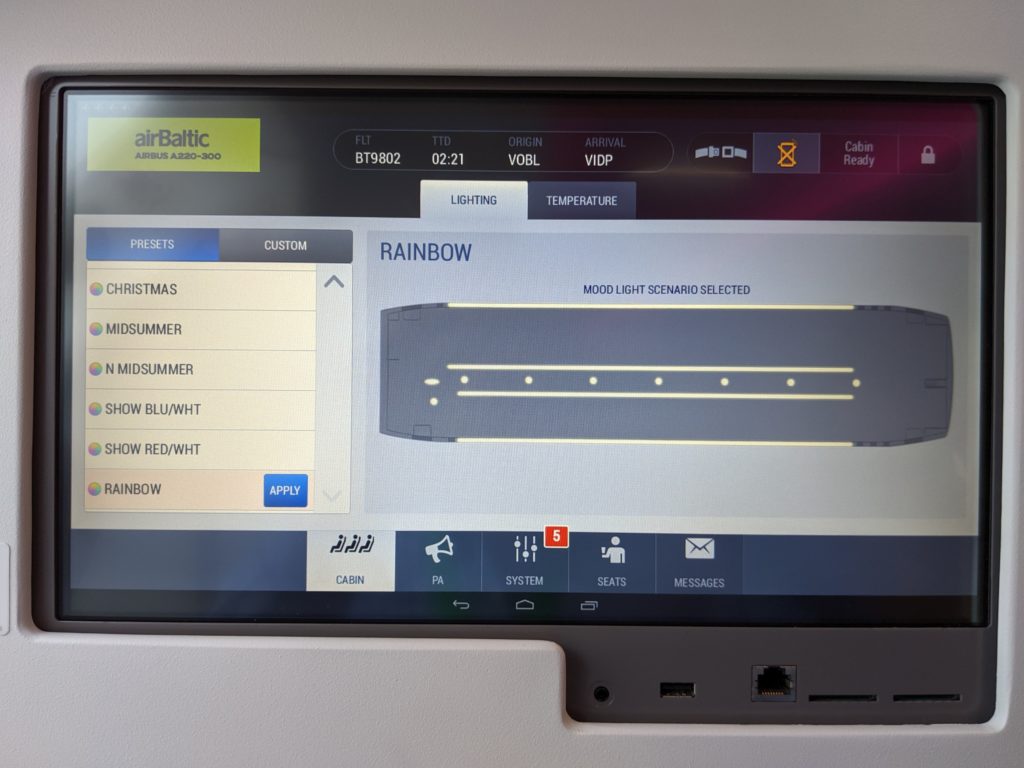
Once we arrived into Delhi, we parked at a bay for Terminal 2, and were bussed to Terminal 3 for exiting the airport.
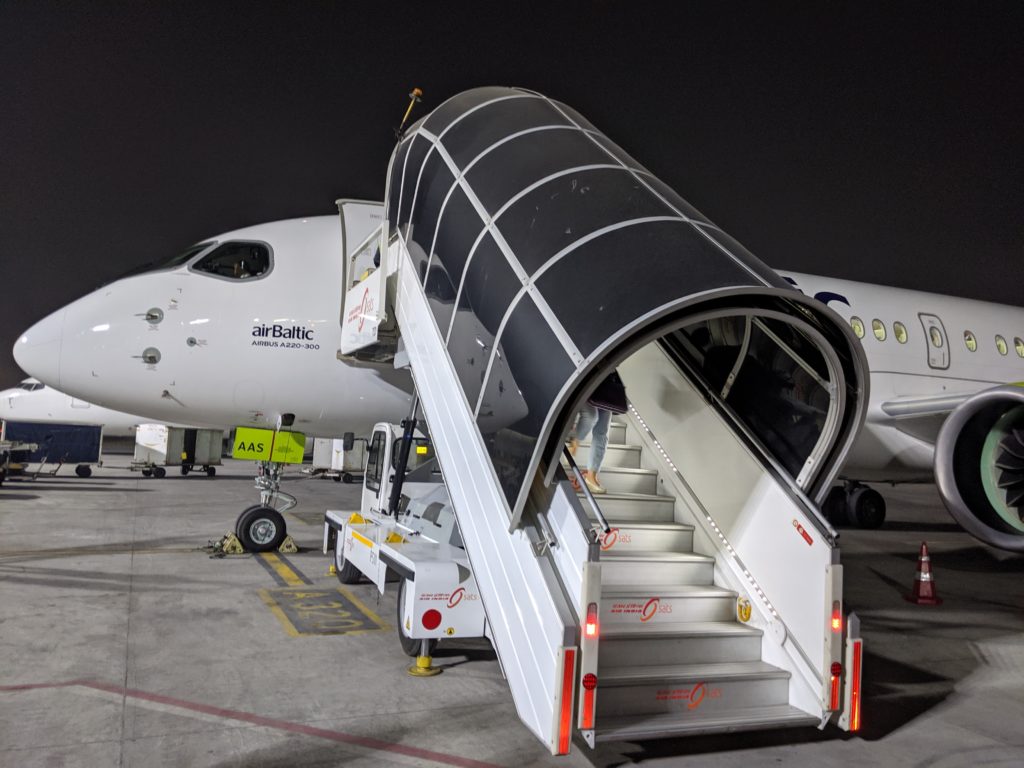
Overall, this was a very smooth aircraft and a great flight, and I’d really hope some Indian carriers would pick up a few of these aircraft because of the various use cases these present, namely the comfort of a narrow-body single-aisle jet, but the economics of a smaller jet. I will be doing another post on economics later, so do watch out for that.
Have you flown the Airbus A220? What is your impression of this new aircraft in the sky?


Small typo:
“an aircraft delivered to Airbus just in May 2019”
i believe, it should be Air Baltic instead of Airbus, right?
Thanks Ajay for sharing and glad you got the chance to take this flight.
look forward to the article on economics of the aircraft, but quite keen to have it flying in India–Would be a great way to fly to smaller airports through new routes 🙂
Very Impressive 🙂
Thanks for sharing.